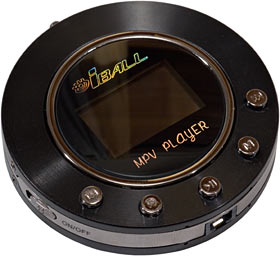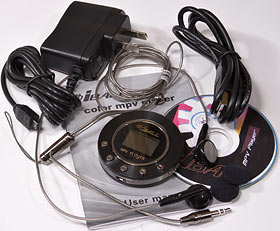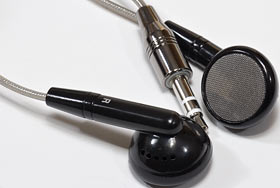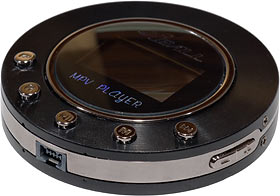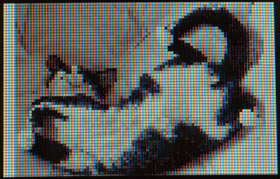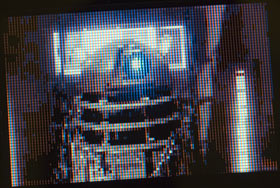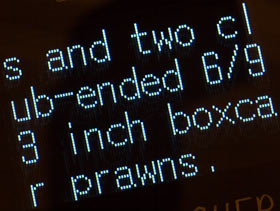
Geil iBall MP3 Video Player
Review date: 16 May 2005.Last modified 03-Dec-2011.
Flash-memory MP3 players are something of a glut on the market. Back when I first reviewed George, affordable flash players were still a bit unusual, Today, you can literally buy the things in seedy discount stores. Flash players these days have to offer something a bit special to raise them above the pack.
This does.
It's Geil's iBall MP3 Video Player, apparently part of their "DAVID series - Digital Audio and Video Intelligent Device".
(As I write this, the iBall is the only actual member of the "DAVID Series", though it does come in 256, 512 and 1024Mb versions.)
As the name suggests, this thing does more than play the usual MP3s and WMAs, tune FM radio and take voice notes - all standard features for pretty much every cheap flash player out there. The iBall has a teeny-tiny colour OLED screen, on which it can play as much video as you can stuff into its memory. It charges its tiny internal lithium ion battery whenever you plug it into its USB cable. And, naturally, it looks like a removable "Mass Storage Device" drive to any recent Windows PC, Mac or (with a following wind and the blessings of the driver gods) Linux box.
The iBall's less than 55mm in diameter (about two and one-eighth inches), a little less than a centimetre thick (3/8ths of an inch), and it weighs about 32 grams (1.1 ounces) without headphones. You could wear it as a pendant, and indeed you're meant to, thanks to the design of the earphones (which I'll get to in a moment) and a little split-ring on the top of the player.
The screen is about 20.5 by 13.5mm in size (0.8 by 0.53 inches). This means it's got a 3:2 aspect ratio, the same as 35mm film. Not quite regular 16:9 widescreen, but wider than the usual 4:3.
Of course, the word "wide" here is used in an extremely loose way. The iBall's screen makes that of a tiny mobile phone look like IMAX.
Here in Australia, Aus PC Market are selling the 256Mb iBall for $AU176 including delivery anywhere in the country, and the 512Mb version for $AU214.50 delivered. Each can be had in black - like my review unit - or silver.
As with almost every storage device, the iBall capacity is stated in powers-of-ten megabytes, rather than the powers-of-two that everyone's operating system (and RAM) uses; the "256Mb" model I got for review had a relatively generous 256,867,776 byte formatted capacity, which is only 245Mb.
You also, as is still usual for flash players, get only USB 1.1, not USB 2, for file transfers. And the iBall doesn't even stretch USB 1.1; its large-file write speed's about 265k/s, and its read speed's about 360k/s.
But still, I hear you say, hurrah!
The (something-like-)512Mb version's obviously the one to buy (well, unless you can buy the 1Gb version where you are; it's apparently not been brought into Australia yet), and that's got enough storage for a couple of standard twenty-something minute TV shows, or one forty-something minute one. You're not going to be watching Revenge of the Sith on a screen this size if you've got a brain in your head, but it'd just about cut it for watching The Daily Show on the train, wouldn't it?
Actually... not so fast. But we'll get to that in a moment.
I've missed my calling. Clearly, I should have been a stylist.
The iBall comes in one of those nifty little magnetic-latch boxes that a few off-brand MP3 player makers now use. Inside, you get the player itself, a USB cable, a paper manual, a 77mm software mini-CD, an AC adapter for charging when there isn't a computer handy, and headphones.
The AC adapter is a world-compatible multi-voltage unit that terminates in a mini-USB plug with, of course, just the +5V and ground conductors connected. Retail iBalls in Australia come with Aussie-style slant-pin AC adapters; the plugpack I got with my review iBall has US-style flat pins.
(To plug a US-pin adapter into an Australian slanted-pins socket, assuming it can handle our 230V mains, you either need to use an appropriate "travel adapter", or bend the pins with pliers. The management disclaims all responsibility if you rip the pins clean off by doing this, or end up with the thing only half plugged in and waiting for something to short the exposed portion of the pins, but I've done it a few times and never had a problem. Caveat lector.)
The iBall's headphones are the "earbud" type that every little MP3 player comes with.
Most bundled MP3 player headphones are pretty darn awful, but these ones, amazingly, do not suck nearly as much. If earbud headphones are all you want to use, then I think you're going to have a hard time finding any that sound vastly better than iBall's bundled 'phones. There's some bass, and everything. It's incredible.
The bundled 'phones are not, of course, going to beat a set of Etymotic canalphones, or compact Sennheiser bass monsters, or indeed cheap and cheerful Koss earmuffs. But as tiny-phones go, they're well above par.
The earphones' wires are laid out so you can loop them around your neck and hang the player off them, and there's a strong (and decorative) mesh shield under the clear insulation, which ought to make the cables tougher than those of the average bundled 'phones.
The bundled 'phones also look good, with metal grilles and a quite classy shiny metal plug. You get a set of foam covers for them as well, if you prefer the squishy feel.
The iBall's controls are little plastic buttons, but they're nice looking little plastic buttons. There's a rocker on the side for volume control; the headphone socket's on the top next to the split ring, the USB socket's on the bottom, and there's an on-off slider on the opposite side to the volume control. The slider doesn't, actually, turn the iBall on; it just makes it possible for you to turn it on by holding down the play/pause button, in the usual Taiwanese-player way.
Odd, but workable enough; you use the slider to lock the player down so it can't turn itself on in your pocket.
There's no "hold" switch to disable the controls while the player's on, but the buttons are all small and firm enough that I doubt they'll be pushed by accident anyway.
The buttons may be plastic, but the iBall's body is aluminium. Thin aluminium - nobody would call the iBall satisfyingly heavy - but the casing still feels rock solid in a way that no plastic flash player can manage. The gently curved plastic lens over the screen seems tough, too; you could easily scratch it, but it'd take more than usual abuse to break this thing.
Audio
For plain music playback, the iBall works pretty much like every other flash player out there. Pick your track with the forward and back buttons, press play/pause to start and stop playback, wind the volume up and down with the little rocker on the side. There's no play resume, which'll annoy audio book listeners, but the thing works essentially as expected.
Leave the player alone for a while and its standard artist-and-title display (including, of course, ID3 tags) changes to a tasteful little green spectrum analyser thing.
You can scan silently through tracks by holding forward and back, and you can repeat a section of a track, a whole track, or the whole contents of the player. Most people don't care about the repeat function, which is good, because the iBall hides the one-track and all-tracks repeat functions away in a menu, and forgets the setting when you turn it off.
There is no random-play feature. I don't think Apple patented it, so there must be some other reason. There's no playlist or folder-play, either.
The stock iBall headphones may be unusually good, but I can't say the same for its sound quality. The iBall seems quite happy driving reasonably beefy headphones to respectable volume, which is good, but no matter what headphones I tried and how low I set the volume, there was distinct, though not loud, treble aliasing noise (that's not necessarily what it is, but it's what it sounds like to me). The iBall offers the usual selection of best-avoided EQ settings; none of them cure the noise.
This isn't as big a problem as you might think, though, because the audio quality requirements for flash players aren't very high. Most of them sound pretty ordinary even with good headphones, but an awful lot of users seem perfectly happy with awful stock earbuds. The iBall earbuds are quite good, and its noise problem isn't noticeable if you Listen to raucous music. You also won't notice it if you're listening on a bus. People don't usually use flash players in "critical listening" situations.
For audio playback, the iBall ought to last at least four hours on a full charge, and maybe six, depending on how often the screen's on. The screen defaults to staying on at full brightness all the time, but you can also set it to dim after five seconds with no button activity while music's playing, or turn off completely after the same delay.
This is done with another menu, but the iBall, thank goodness, remembers the screen saver setting when it's off. The setting also works when the iBall's plugged into a PC, which is good; by default the screen's on constantly when the player's USB-connected. It also seems to never stop charging when plugged in, though I left it that way for a day and it didn't catch fire.
The iBall's FM radio feature is, as usual for flash players, fiddly. You can only get into it via another darn menu (though you can get out by holding the M button). Then, there's a plain "Listen" mode, and an auto-search mode that's only mildly painful to use. The iBall can save up to 30 stations, which is handy; you can also jockey the tuning around with taps of the volume control, though this of course makes fine volume adjustments annoying.
Like all teeny FM radios, the iBall uses the shield conductor of the headphone cable as its antenna, so don't expect to pull in any distant stations or get a perfect noise-free signal as you wander around. I found it pulled in a local low power community station quite well, but since their transmitter's only about a kilometre and a half away from me, that wasn't totally amazing.
The iBall's voice note feature is, surprisingly, quite easy to use, though it's got some quirks of its own.
You can go into voice note mode via yet another menu, which is of course clumsy and unsuitable for quick note-taking - but you can also do it by just holding the M button. Nice.
Once you're in note mode, the R button means Record, and you use the play/pause button to pause and resume recording - a useful feature which many flash players don't have - or stop altogether, by holding the button. A tap of the M button gets you back to music mode.
As with every record-capable flash player I've played with, the integrated microphone in the iBall works surprisingly well. It's omnidirectional, and it deals well with ordinary speech at ordinary arm's length. It doesn't work quite as well as some other flash player mics, but this is probably because I can't actually tell where the darn mic is. There's no little hole to indicate the location. Enough sound leaks in past the buttons, or through the USB socket, or whatever, for the thing to work.
(The iBall casing, by the way, has tiny concentric grip-ridges on it, front and back, that're sharp enough that you can use the player as an emergency nail file. If you do this while recording a note, or even handle the player wrongly, the result will sound as if it's come from the Land Of Corduroy. So don't do that.)
The iBall's other record-mode quirk has to do with its recording formats. It can encode voice notes as standard four bit, 8kHz (thus 32 kilobits per second) ADPCM WAV files, or it can save them as much smaller (and crappier sounding) G.723 ASF files.
If you're recording a lecture to an iBall that's almost full of MP3s, ASF format's the one to use; it's still comprehensible enough, despite distinct underwater noises.
Whatever recording format you choose, though, is the one you have to use until you turn the player off and on again. If you start out recording one or more notes with the default WAV format, then switch to ASF (via, you guessed it, a menu) without turning the player off, the ASF files you then make will be royally munged. The player won't even attempt to play them back, and you'll have no more luck playing them on a computer.
Likewise, if you record your first clip in ASF format, switching to WAV will give you screwed-up files. The player will at least attempt to play these back, but they'll be entertainingly garbled.
It's easy to tell when this problem's happening. While you record a munged ASF, the record-time counter increments about twice as fast as it ought to. It increments at roughly half speed while you record a munged WAV.
This problem is, of course, easy to avoid - but it pays to know about it before you start recording Jimmy admitting he's sold you out to the cops.
Video
The iBall can display video. Heck, it can display still pictures, too, and slideshows.
Its screen, as mentioned above, is not big. It's also not high resolution. You get 96 by 64 pixels. Deal with it.
On the plus side, it's an OLED screen.
OLED screens are, potentially, great.
The perfect screen would have little (preferably very little) square pixels that could light up any colour. Nobody's come up with a technology that can do that yet, so square-pixel flat panel monitors of all types - LCD, plasma, OLED - all have pixels that're each made out of three tall rectangular subpixels - one red, one blue, one green.
OLED implements this the sensible way. Each subpixel is a little light-emitting diode that lights up the appropriate colour. Easy.
LCD implements this the dumb way. Each subpixel is actually a colourless liquid-crystal-and-polariser sandwich, which can let (most) light through or block it (almost); there's a filter of the appropriate colour somewhere in the sandwich, and there's a white backlight behind everything.
The cheap LCDs in various phones, MP3 players and suspiciously inexpensive digital cameras have lousy viewing angles - your sight-line has to be pretty much perpendicular to the screen for it to look right. And they aren't terribly bright. And they can't do a proper black - significant light always leaks through from the backlight. And they generally have miserable pixel response times, so fast motion blurs badly.
OLED has no viewing angle problems, and is bright (though still not bright enough for use in direct sunlight), and can display super-fast action, and nice dark blacks. And little OLED screens are now cheap enough that, well, they're showing up in iBalls.
The problem, regrettably, is that OLED screens wear out. Fast. The red subpixels last for ages, the green ones last a while, and the blue ones die - or, at least, fade to a small fraction of their original brightness - in a couple of thousand hours, at most. The OLED companies promise that this'll change soon, but it hasn't yet.
An OLED screen won't be useless even if its blue channel's completely dead, of course; any colour but pure blue will still be visible, just without the blue component. But, as I've said before, this problem still rules OLED out for long term video display purposes.
A flash player with a great video mode but an OLED screen is, therefore, not a brilliant option for watching a whole lot of stuff on, even if the screen's high res.
Of course, only half an hour a day of TV watching on public transport would still let a 2000-hour OLED screen last until the lithium ion battery gave out.
But, I'm afraid, iBall buyers aren't likely to be in that position. Because the iBall's video support is - there's that word again - quirky.
The iBall doesn't, you see, play any normal PC or Mac video format. It plays something called "MPV files". You get a utility with the player that converts regular video into MPVs.
Now, on the face of it, this makes sense. It's daft to copy a whole 624 by 352 pixel TV rip (for instance) onto a player that can only actually display one thirty-sixth of that file's full pixel count. Much better to preprocess the thing down to 96 by 64, vastly reducing its file size (even if the final format's some easy-to-play-on-low-power-hardware basic MPEG variant) and copying time.
Trouble is, that's not what the iBall converter software does.
First, some good news: You get a program that makes slideshows, with any number of images in them you like, and it accepts normal images (including really high-res ones, though they take a little while to process), and lets you have a single image for static display if you like, and makes tiny little final files (85k for seven frames), which are quite easy to display (though, yes, there's another menu involved). Setting inter-frame delays is a little screwy, but I figured it out.
The slideshow maker can't actually load existing slideshows, so if you want to modify one you have to make it again from scratch. But it'll do.
The resolution's still not exciting, of course, and the iBall only seems to be able display 15 bit colour at best (amazingly, banding is still visible on the tiny screen), and images like this one that aren't cropped to the same aspect ratio as the screen will have white borders. But given the tiny size of the screen...
![]()
...roughly represented by this scaled pic, image display works fine.
If you want a pendant that shows a series of teeny images as you bop around the club, the iBall will do it.
(You can't listen to music while displaying pictures, though.)
Video is less fun.
When I converted a 350Mb DivX TV-rip of the abovementioned 624 by 352 resolution to MPV, the resultant file had crummy 64 kilobit audio, but was still a monstrous 269Mb. A 163Mb Daily Show crunched down to 131Mb (and took nine minutes and forty seconds to do it, on my 3.3GHz P4 test machine - plus another 12 minutes to copy the file to the player through its none-too-speedy USB 1.1 interface).
ASF/WMV files were even worse - they got bigger! A couple of small clips blew up from 1.1Mb to 2.87Mb, and from 756k to (wait for it) 5.82Mb. A 14.3Mb clip shot up to 47.4Mb.
MPEG files, being less heavily compressed in the first place, weren't quite as bad - a 4.64Mb clip blew up to 6.97Mb, and a 4.12Mb one with higher image quality shrank to 3.38Mb.
The converter's supposed to work with QuickTime files as well (.MOV, .QT), but I tried several, and it couldn't read any of them.
And - get this - every one of the files that it could convert ended up playing at only eight frames per second, with obvious top-to-bottom painting of the screen. I know the screen can manage much better frame rates than that - you can make slideshows that rip past at lightning speed, with no blur - but you wouldn't know it, from the video playback.
The TV-rips were 30fps to start with. So halving the audio bit rate, dividing the video res by 36, and dropping the frame rate to 27% of what it used to be resulted in a file around eight-tenths as big.
The file sizes were actually pretty close to what you'd get if the converter was saving uncompressed two-byte-per-pixel 96 by 64 frames, along with 64 kilobit per second audio and a bit of overhead. Tell me that's not what's going on.
The above audio and frame rate specs, by the way, are the only ones that the bundled iBall software offered. This isn't the same software that some other iBall buyers apparently got - these guys got a version that allows different frame rates (and connected audio bit rates).
They probably got a better license agreement than I did, too.
So I started looking for different software, and firmware updates.
Right here there were links to a firmware update, and instructions. That, um, didn't exist. Geil's Taiwanese site wasn't any more helpful, but at least didn't lead me on like that.
The Chinese site, though, had three kinkily named iBall-relevant downloads, and the RAR archives were bigger than one byte!
Hmm. Docs, in Chinese. OK, no problem.
I_Ball_SP1.rar, with a "New!" icon, presumably was meant to contain new firmware... but the archive was corrupt. Excelsior!
And then, there was i-Ball.rar, with some maybe-firmware thing, and another pic utility (which I didn't need), and... an updated GMV-tools!
The video portion of which had a legible license agreement, but did nothing but crash, for me. Your mileage may vary.
After this brick wall, I tried to figure out what the heck MPV format was, according to the iBall, in hopes of finding some other way to make it.
Most PC apps that have any idea what a .MPV file is will assume it's the Music Photo Video playlist format. They will also choke, with varying degrees of elegance, when fed an iBall file, which definitely isn't that format.
MPV's also a mildly obscure suffix that some people use on MPEG-compressed video files with no audio; there, it stands for MPeg Video. IBall files aren't MPEGs, either.
And then there's this page, which says the iBall can "decode GMV video files".
GMV is a Los Alamos National Lab 3D visualisation tool. That's all it is, as far as I know. So no help there.
The header of the MPV files contains the strings "WEIKENG" and "MP3 R&D" (and nothing else comprehensible). Trawling through a couple of reseller sites by that name got me nowhere, except for a couple of glimpses of the Sunplus logo. Sunplus is the maker of some portion of the iBall chipset (the name's reported during the USB detection process), but there are no hits for "MPV" on their site.
Urgh.
There's definite potential in the iBall's video mode. The image quality's not too awful...
...considering the resolution, and this thing can definitely display a smooth frame rate.
But if the MPV format can't be persuaded to make reasonable sized files, the whole exercise is doomed to failure even if the converter software's fixed.
Oh - you can pause video on the iBall, but you can't seek through it. Just so you know.
Other tricks
The iBall can display text files. Put file in correct folder (everything you want to play on an iBall, except voice notes, goes in "PIC"), use another mildly annoying menu, and...
...you can view 24 whole characters at a time. The characters are a pleasant 12 pixels high, but that means you only get four lines of 12.
(The text is blue-green, by the way. Or, after extensive use, green. Or, some time later, invisible. Text doesn't energise a whole lot of subpixels, though, so this shouldn't be a real problem even if you for some reason use this mode all the time.)
Minimum fixed-width character size, if you want both upper and lower case, is nine pixels high by four wide; allowing for spaces between characters and lines, such a font would've allowed six lines of 19 characters - well over twice as much text per screen.
A bit teeny, sure, but nobody with bad eyesight should buy an iBall anyway.
If you've just got a little shopping list to view, the iBall text mode could be slightly useful. If you're reading Moby Dick, it'll take around 24,850 presses of the "forward" button.
There is no bookmark feature.
Enjoy.
The iBall also has a simple file-delete feature, which lets you blank the player completely, or delete files one by one. Deleting 12 files this way will annoy you deeply, and it is of course much easier to do this sort of thing with the iBall plugged into a PC. But if you just need to get rid of that one-file concept album to make more room for voice notes, it'll do.
Overall
Everybody knows what the most popular Flash player in the world is, right now. It's the market-eating iPod Shuffle. The Shuffle avoids the Giant Swiss Army Knife Syndrome from which so many flash players suffer. It's got no screen, no radio, no note-taking, no line in, no free set of steak knives. Just a simple interface, long battery life, and a decent amount of memory at a decent price.
Here in Australia, Apple are currently selling the 512Mb Shuffle for only $AU149, delivery included. The 1Gb version's $AU229. Only slightly more expensive than the 512Mb iBall, with twice the memory, and (now that you aren't forced to use iTunes any more), no quirks.
If all you want is a plain MP3 player, and especially if you like random play (I do; some don't), then you're deranged if you buy an iBall, or indeed practically any other Taiwanese flash player, instead of a Shuffle.
The off-brand players all have interfaces that feel like Rubik's Tamagotchi compared with the Shuffle. There's just no comparison.
Fortunately, the iBall's still got stuff going for it, even though its video feature is nearly useless at the moment.
The going rate for basic FM headphone radios, complete with awful earbuds, is currently around $AU9 at your neighbourhood All Products Proudly Made By Peasants discount store, so that's not what you'd call a premium feature. But it's still nice to have, and $AU9 radios don't have memory settings.
The iBall's note-taker feature also works OK. Again, you can get standalone notetakers cheap, but they don't have USB connections to offload the files as WAVs.
And the iBall can display photos, on an incy wincy screen. This feature is highly desirable in the 12-year-old-girl and very cheerful clubber market segments.
More practically, the iBall's OLED screen always looks great. It's clear, it's classy, and if you turn on the dimmer or blanking feature, it ought to last well.
And the iPod Shuffle may be ten grams lighter than the iBall, but neither of them weigh much, and the iBall has a metal case. It doesn't look like a Taiwanese clone-player. It looks, and feels, really nice. Well, until you hit the user interface, anyway.
Oh, and the iBall comes with a mains charger.
So, despite its quirks, I like the iBall. Not everything works, but that's OK, as long as you only want what does work.
Looks great, feels OK, works well enough, not stupidly expensive, for what it is.
Recommended.
Buy one!
Readers from Australia or New Zealand can purchase the iBall from Aus PC
Market.
For the silver 256Mb version,
click here.
For the black 256Mb version,
click here.
For the silver 512Mb version,
click here.
For the black 512Mb version,
click here.
(if you're NOT from Australia or New Zealand,
Aus PC Market won't deliver to you. If you're in the USA, try a price search
at
DealTime!)
